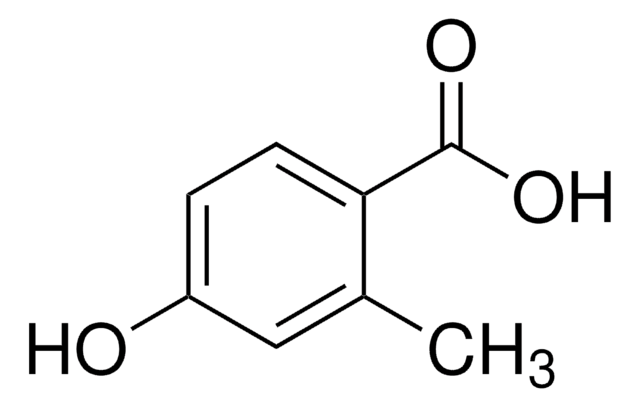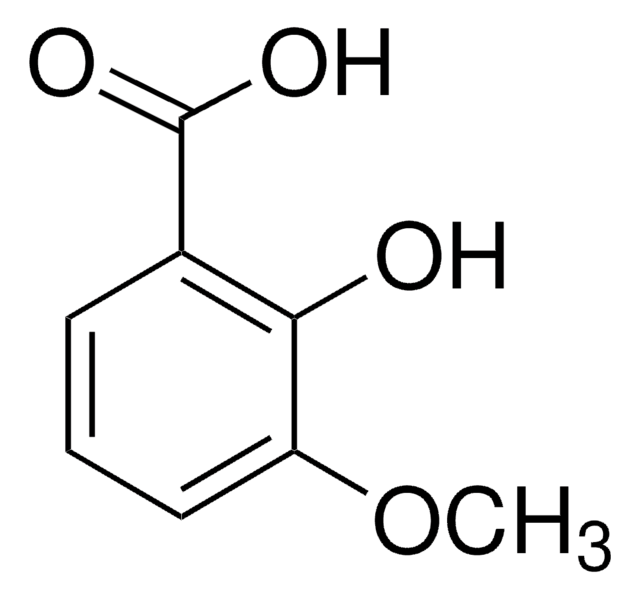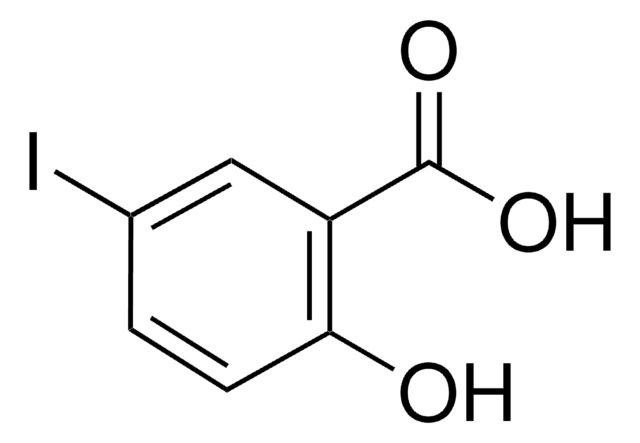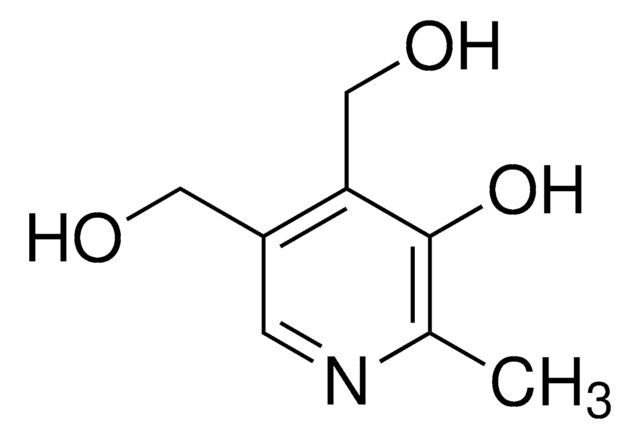173479
2-Hydroxy-4-methoxybenzoesäure
99%
Synonym(e):
4-Methoxy-salicylsäure
Anmeldenzur Ansicht organisationsspezifischer und vertraglich vereinbarter Preise
Alle Fotos(2)
About This Item
Lineare Formel:
CH3OC6H3(OH)CO2H
CAS-Nummer:
Molekulargewicht:
168.15
EG-Nummer:
MDL-Nummer:
UNSPSC-Code:
12352100
PubChem Substanz-ID:
NACRES:
NA.22
Empfohlene Produkte
Assay
99%
mp (Schmelzpunkt)
158-159 °C (lit.)
SMILES String
COc1ccc(C(O)=O)c(O)c1
InChI
1S/C8H8O4/c1-12-5-2-3-6(8(10)11)7(9)4-5/h2-4,9H,1H3,(H,10,11)
InChIKey
MRIXVKKOHPQOFK-UHFFFAOYSA-N
Verwandte Kategorien
Anwendung
2-Hydroxy-4-methoxybenzoic acid (4-methoxysalicylic acid) was used in the synthesis of 1,3,4-oxadiazole derivatives.
Signalwort
Warning
H-Sätze
Gefahreneinstufungen
Eye Irrit. 2 - Skin Irrit. 2 - STOT SE 3
Zielorgane
Respiratory system
Lagerklassenschlüssel
11 - Combustible Solids
WGK
WGK 3
Flammpunkt (°F)
Not applicable
Flammpunkt (°C)
Not applicable
Persönliche Schutzausrüstung
dust mask type N95 (US), Eyeshields, Gloves
Hier finden Sie alle aktuellen Versionen:
Besitzen Sie dieses Produkt bereits?
In der Dokumentenbibliothek finden Sie die Dokumentation zu den Produkten, die Sie kürzlich erworben haben.
Zhi-Ming Zhang et al.
Bioorganic & medicinal chemistry, 20(10), 3359-3367 (2012-04-24)
A series of 1,3,4-oxadiazole derivatives derived from 4-methoxysalicylic acid or 4-methylsalicylic acid (6a-6z) have been first synthesized for their potential immunosuppressive activity. Among them, compound 6z displayed the most potent biological activity against lymph node cells (inhibition=38.76% for lymph node
Francesca Bonvicini et al.
The new microbiologica, 41(3), 187-194 (2018-06-07)
Herpes simplex virus types 1 (HSV-1) and 2 (HSV-2) cause several clinically relevant syndromes in both adults and neonates. Despite the availability of efficient anti-HSV agents, the search for new therapeutic approaches is highly encouraged due to the increasing drug
Fei Zheng et al.
Xenobiotica; the fate of foreign compounds in biological systems, 49(9), 1025-1032 (2018-10-24)
1. Anthocyanins (ACNs) are a subclass of polyphenolic pigments belonging to the flavonoids and constitute an important group of human diets. There is accumulated evidence that consumption of ACN-rich diets such as Vitis amurensis Rupr of "Beibinghong" exerts protective activities
Lenka Applová et al.
Molecular nutrition & food research, 63(20), e1900261-e1900261 (2019-07-26)
Intake of flavonoids from the diet can be substantial, and epidemiological studies suggest that these compounds can decrease the incidence of cardiovascular diseases by involvement with increased platelet aggregation. Although parent flavonoids possess antiplatelet effects, the clinical importance is disputable
Violetta Mohos et al.
International journal of molecular sciences, 20(11) (2019-06-05)
Quercetin is an abundant flavonoid in nature and is used in several dietary supplements. Although quercetin is extensively metabolized by human enzymes and the colonic microflora, we have only few data regarding the pharmacokinetic interactions of its metabolites. Therefore, we
Unser Team von Wissenschaftlern verfügt über Erfahrung in allen Forschungsbereichen einschließlich Life Science, Materialwissenschaften, chemischer Synthese, Chromatographie, Analytik und vielen mehr..
Setzen Sie sich mit dem technischen Dienst in Verbindung.









